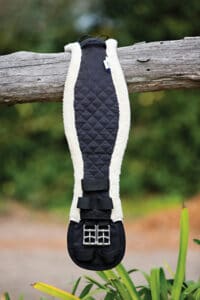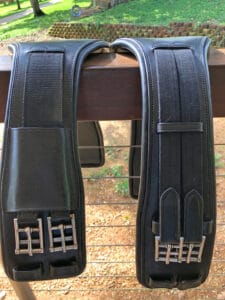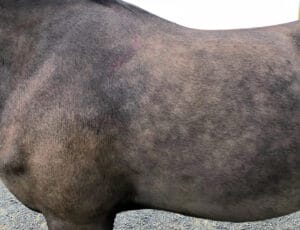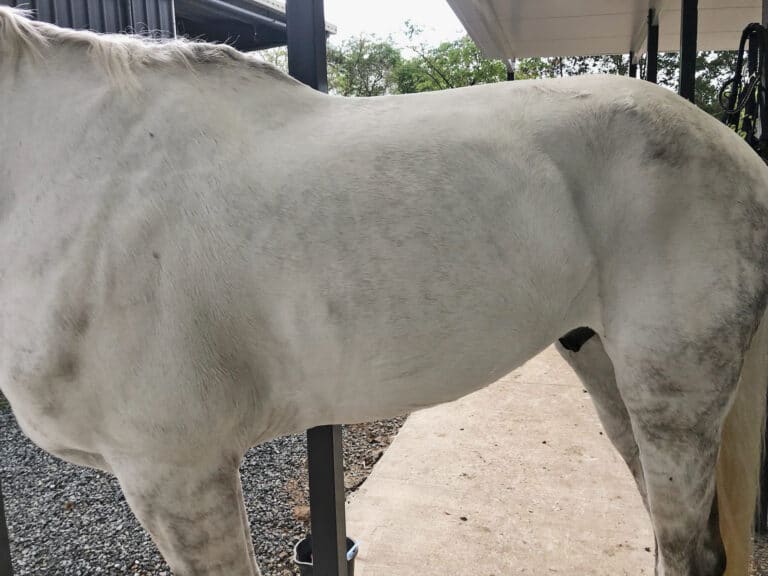In Part One of this two-part series, expert saddle fitter KATHRYN SULLIVAN-BUTT explores the often puzzling world of the English saddle girth. Are all girths created equal? Definitely not!
Walk into any saddlery, or fossick through your saddle fitter’s selection and you’ll likely find an array of different girths. Forward, anatomic, H, elasticated or not, padded and more. What does it all mean and more importantly, do these options actually make a difference?
As the science into saddle fit and design continues to expand our knowledge, the answer is irrefutably yes! Girths do matter.
Girth care
Before getting into design, let’s consider girth care. Girths are manufactured using an array of materials, from easy clean synthetic options to sheepskin or padded leather girths. Preventing girth irritation and galls is always a consideration for the competent horse owner, and regardless of the material used, girths must be kept clean and in good condition.
For leather girths this means wiping them clean after every ride and nourishing regularly, as the salt in sweat will dry out and crack the leather if it’s not cared for. Sheepskin girths, often a favourite of the sensitive skinned horse, need to be kept clean and stored in well ventilated areas so they dry after use, preventing deterioration. A synthetic girth designed to be hosed clean should be cleaned and allowed to dry out of the sun. Think of your horse’s girth as you would a pair of your socks – to prevent irritation, you’d want them to be dry and free of dirt, sweat and mud when you put them on.

As part of your tack maintenance, check girth stitching and wear. View and feel the inside of your girth to ensure there’re no worn edges or cracks that may affect safety and your horse’s comfort. If used regularly all girths have a safety and care use by date, but proper maintenance (ask your saddle fitter or read the manufacturer’s guide lines if you’re not sure) will prolong their life. Once the surface that sits against the horse’s skins becomes cracked and rough, or elements of wear affect safety, it’s time to retire your girth.
Elastic or not?
There are many arguments for and against elasticated girths. It’s true that the elasticated variety do potentially allow more give for the horse’s ribcage during respiration, or in the bascule over a jump. Additionally, for small or arthritic fingers an elasticated girth can assist in getting the saddle done up on a horse that bloats (blows out during girthing).
The flip side is that elasticated girths can be overtightened leading to horse discomfort, or allow more movement and therefore be less stable. The elastic is also often the first part of the girth to deteriorate and should be checked regularly. Once elasticity is lost, the girth needs to be retired or the elastic replaced. If purchasing an elastic girth, the quality of the elastic will be a major factor in the girth’s longevity.
The general consensus amongst fitters and saddlers is that non-elasticated, or girths with small amounts of elasticity (quality elastic doubled or tripled for strength and durability, for example), are better than girths where the elastic stretches to double or more in length. And beware girths with elastic on only one side, which provide uneven tension and may even pull a saddle and rider to one side. They should only be used for remedial saddle fitting in conjunction with professional fitting advice.

Ultimately, the most important factor in deciding whether to go elastic or not is your horse. Many horses give a clear indication as to which they prefer, and for this reason a saddle refit often entails trialling a different girth to evaluate the horse’s response.
Where should we buckle up?
Where you buckle up will differ between long girths that buckle under the flap (long girth/short points as per many jump or all-purpose saddles) to short girths/long points that buckle below the flap. When buckling a long girth, the rider’s leg is a major consideration. The girth should buckle behind the rider’s knee, rather than under the area on which the leg rests.
With a short girth in combination with long points, as in most dressage saddles, the primary consideration is the location of the buckles and associated pressure for the horse. Due to a confluence of nerve endings, sensitive skin, and muscular anatomy, as well as the chance of the elbow catching on the girth buckles, it’s recommended that the girth be buckled up as high as the saddle flap and saddle cloth allow. There should still be one or two holes available to allow for comfortable tightening of the girth without it reaching the saddle flap or scrunching up the saddle cloth. And on that note, smaller ponies, Galloways, or petite horses are often tacked up with saddlecloths that are far too long. The saddlecloth should be shortened so the correct girth length is easily accommodated.

You may not always use the same hole on your girth points when buckling up your girth. This may be for a variety of reasons, including the shape of the barrel and drop of the horse’s belly; where the points are stitched to the saddle and how even they are; the angle of the strap coming down; and girth buckles that are offset. It’s not important that the girth buckles up to the same hole number front and back, but that the tension is approximately equal on the girth points. However, buckles should be approximately even on the left and right side of the horse especially with anatomic shaped girths, which are designed for the girth to sit centred over the sternum.
Shaped and anatomic girths
Where the girth sits (the girth groove) on a saddled horse is determined by the anatomy of each individual horse. Wide girth grooves accommodate large padded girths, which reduce pressure per square centimetre and avoid localised pressure. However, other horses may have a narrow girth groove – a dropped belly behind the girth groove, an elbow that catches on the girth as the shoulder retracts, a wide or narrow sternum, or a combination of all of the above – which will affect how different girths sit.

To accommodate these differences in shape, a variety of shaped and anatomic girths are available. By distributing pressure over a padded or supported round centre, some reduce sternum pressure, or reduce elliptical pressure where the force is greatest and where many girths buckle up. Many anatomic girths scoop back so the shoulder is less likely to catch or chafe on the girth. Different horses will respond differently in various anatomic girths, which is why good saddle fitters carry a range of different options as one size (or shape) certainly does not fit all.
Girth options are endless and so careful selection with informed advice will assist in the best outcome. What works for a friend’s horse may very likely not work for yours, unless you understand why you are making that choice. Of course, horses being horses, it is often only until you try a girth that you’ll have the answer as they truly must have the final say.

Stay tuned for the next issue of Equestrian Hub Magazine, when we’ll get into forward and rearward girths – when to use them or not, and why. Combined with correct girth point selection, they may help prevent saddles shifting forward or back.



